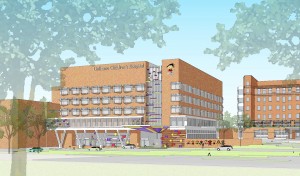The UR Medical Center has launched a $100 million campaign to radically transform Golisano Children’s Hospital as part of the Meliora Challenge, UR’s recently announced $1.2 billion capital campaign.
URMC announced the ambitious $100 million goal, which is one part of its own ongoing $650 million capital campaign, at the 24th annual Children’s Hospital Gala, an elaborate fundraising event that brought together patients, families and community supporters at the end of October.
The hospital’s $100 million campaign, half of which has already been raised thanks in large part to a $20 million gift from its namesake Thomas Golisano in July, has two components.
A little more than half of the campaign capital — $60 million — will go toward the first component: a new hospital, which will be connected to the current facility and will be the largest capital project in UR’s history. The remaining funds will go toward an aggressive push to advance research and education.
A groundbreaking for the new hospital is slated for August 2012, though the planned 200,000 square foot, seven-story building is still in the planning stages and must be approved by the state before construction can commence.
As of now, the hospital will contain pediatric imaging, two in-patient pediatric bed floors, a neonatal intensive care unit, a pediatric intensive care unit and a surgical floor.
URMC Chair of Pediatrics and pediatrician-in-chief of Golisano Children’s Hospital Nina Schor said the hospital’s programs are “literally poised” to propel the hospital from a regional presence to a nationally recognized facility, but are somewhat constrained by space and a lack of a cohesive identity separate from Strong Memorial Hospital, she said.
Two key factors are driving the decision to build the new hospital.
The first is a lack of continuity in pediatric radiology between the children’s hospital and URMC — children who need X-rays must be wheeled into the main building — a detriment that is symptomatic of the hospital’s overarching predicament: a need for more specific equipment and space tailored to the needs of children. The hospital also currently has no uniquely operated pediatric surgical rooms and has to rely on ones that serve both adults and children.
“We wanted to house everything a child could need as an in-patient in one building,” Schor said.
The second factor is a need for single rooms. Currently, the pediatric hospital has all doubled-bedded rooms, with a targeted occupancy of 56 patients. This limits privacy and makes it difficult for families to stay overnight with a child in a double room — “not the best setup,” Schor said.
Double patient rooms are also not an ideal setup because of the need to isolate children with the flu or other contagious diseases.
“Although we are bedded for 56 patients in our pediatric ward, when a substantial part of them have an infectious disease and have to be isolated, we cannot put 56 patients in it,” she explained.
The new hospital will expand space for the neonatal intensive care unit and hopefully contain 68 beds, according to Schor. The current neonatal facility has 52 beds, but is sometimes forced to house as many as 72 patients, which is “way out of the realm” of what is stipulated in state code, Schor said.
The new building will also have a clearly separate entrance and an aesthetically appealing lobby area catering to the needs of child patients and their families.
Schor estimated that in 30 to 32 months from the groundbreaking, regular pediatric bed floors will be ready for occupancy, while the more intricate internal construction will likely take 18 more months to complete.
She is also optimistic about the feasibility of fundraising, describing it as a “five-year window” over which donations and pledges will be spread.
URMC CEO Bradford Berk echoed this optimism in a statement after the campaign was formally announced.
“This is an aggressive but attainable fundraising goal,” he said. “This is an incredibly giving community that understands that a new children’s hospital is critically important.”
The second facet of the $100 million campaign will target research in seven critical areas: cancer, neonatology, autism, eating disorders, cardiovascular disease, surgery and supportive care.
Expanded research opportunities will likely affect graduate students, as Schor said the campaign aims to raise money to support additional endowed research fellowships. Fellows are M.D.’s who have completed their residency.
“The campaign is likely to bring in more fellows, so we’re not constantly scraping together funds to support them,” Schor said.
One area of research that stands to benefit from the campaign is eating disorder treatment. Eating disorders affect an estimated 10 million people nationwide and have the highest mortality rate of any mental illness.
Richard Kreipe, a professor in the Department of Pediatrics in the division of adolescent medicine, said that the Child and Adolescent Eating Disorder program at Strong has been seeing a “steady” demand for eating disorder treatment. While the hospital never turns anyone away, there is sometimes a wait of two weeks before a patient can receive an eating disorder evaluation, he said.
Kreipe said that having private rooms, as planned in the new hospital, would make it much easier to conduct family sessions with eating disorder patients in private. Family sessions are a widely used treatment method, especially for younger adolescents. While the new building would not allow for more inpatient space for eating disorder treatment, it would allow for “more usable space,” he said.
The program has already expanded outpatient services to include young adults up to 25 years old because of demand, and has patients up to 18 years old on the inpatient unit. With the campaign funding, Kreipe said it would be possible to expand services down to younger patients, as unfortunately the program has recently seen a need for treatment from patients as young as seven years old.
Kreipe also foresees the possibility of expanding treatment tactics as the frequency of eating disorders rises and treatment methods evolve.
“We have always included families in treatment, but we would like to expand our post-hospital treatment by maintaining close connections with parents after discharge from the hospital,” he said, adding that he wants to work with schools to identify eating disorders earlier, often a crucial factor in the success of treatment.
“I believe that the best way to reach parents with a daughter or son who has an eating disorder is through the Internet,” Kreipe said. “We have lots of ideas about how we can do that with additional funding.”
Developmental and behavioral pediatrician at URMC and assoicate professor of pediatrics Susan Hyman said she thinks one asset of the new hospital will be its sensitivity to “the motor needs of children and family members who have limited mobility,” and also to the needs of children with vision and hearing impairments.
Hyman, who conducts research on autism spectrum disorders, described what she thinks will be a “welcoming environment.”
“The emotional needs of families will be considered in all aspects of space planning,” she said. “[The campaign] confirms UR’s commitment to children and families for patient care and for the research that will continue to keep us at the cutting edge of pediatric medicine.”
Buletti is a member of the class of 2013.



